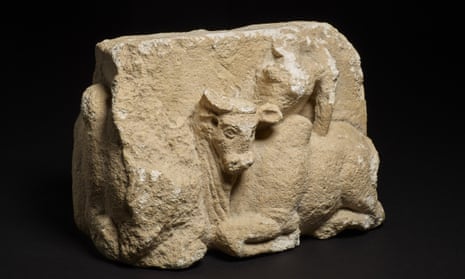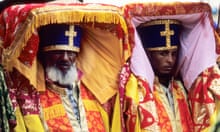A sculpture that was stolen from the National Museum of Afghanistan in Kabul almost 30 years ago is to be returned to its country of origin after being seen on a British auctioneer’s website and investigated by the Metropolitan police.
Carved in the 2nd century AD from a yellowish limestone, the sculpture of two bulls was excavated in the 1950s in northern Afghanistan only to be looted during the civil war in the early 1990s, following the withdrawal of Soviet troops. Where the bulls have been since then is unknown, but they were spotted by the Art Loss Register (ALR), which has an international database of stolen artworks, on the website of Timeline Auctions, and reported to the police.
The seller immediately relinquished ownership and its status was confirmed by the British Museum, where Dr St John Simpson, a senior curator, recognised the sculpture immediately. “It’s a very well-known, unique piece,” he told the Observer.
Further confirmation came from the Kabul museum, which has allowed the sculpture’s first public display outside Afghanistan before it is returned. The British Museum will show it from Mondayfor about three months. James Ratcliffe of the ALR said: “We are delighted that our identification of this piece … led to its seizure … We would like to thank the Metropolitan police for their swift action in seizing it … and the British Museum for their subsequent assistance.”
Christopher Wren of Timeline said the auction house employed the ALR “to check all Western Asiatic items submitted to us for possible sale, so it was directly at our instigation that the piece was identified.” He added: “We also liaise closely with the Art Squad of the London Metropolitan Police and with other authorities in our constant endeavours to ensure that stolen or looted pieces are not offered and can be returned to their proper home. We have been instrumental in the recovery of several other items over the last few years as a direct result of our policies. The vendor in this case innocently came into possession of the piece many years ago and, on being informed of the origin… immediately relinquished any claim to ownership and agreed that it must be returned to the Museum at Kabul.”
Depicting a reclining humped bull with its face turned to the viewer and the front of a second bull on the left, the sculpture was excavated from one of Afghanistan’s most significant ancient sites, Surkh Kotal, where monumental buildings were constructed during the rule of the Kushan kings, whose empire once stretched across modern-day Afghanistan, Pakistan and northern India – an area known as Bactria.
Originally discovered by a French archaeological expedition, it was among carved limestone blocks that once formed part of a ceremonial frieze showing human figures and bulls. It had adorned the inner sanctuary of Surkh Kotal’s temple, which was built in the 2nd century AD.
Also found within that temple site was an important sculpture of the great Kushan king, Kanishka I, famed for his tolerance of faiths and under whose reign Buddhism began to spread widely in Afghanistan.
Simpson said: “That sculpture is an icon of discovery, destruction and restoration because it was on open display in the National Museumand was sledge-hammered by the Taliban minister of culture when they began the wave of iconoclastic destruction in 2001. And yet that piece has now been restored and is back on display in that museum…
“This piece that we’re dealing with now is another symbol of recovery from that same temple. It is the only one to be recovered. All of the other limestone blocks – more than a dozen – are still missing.”
Hartwig Fischer, director of the British Museum, described the rediscovery of the sculpture as “another very important step in the reconstruction of the rich cultural heritage of Afghanistan after decades of conflict, destruction and loss”. About 75% of Kabul Museum’s antiquities have been destroyed or looted. Although Afghanistan continues to suffer deadly violence, the museum has been restored and is open to the public.
Working closely with the police, the UK Border Force and other agencies, the British Museum has helped to recover thousands of looted antiquities from Afghanistan since 2003.
Simpson said Surkh Kotal was excavated in the 1950s and early 1960s and partially restored, “but then totally ransacked and looted and pitted during the civil war period. So it’s in a complete mess now.
“Archaeological sites are even more vulnerable than the built museum environment at times of loss of central control. There’s not an archaeological site in Afghanistan that’s been untouched by this wave of looting.”
It makes the recovery of such sculptures all the more important, he said, “but it’s tinged with inevitable sadness that at times of conflict, museums and places of culture are deliberately targeted.”










